You are reading the older HTML site
Positive Feedback
ISSUE
21
equarack
Model A Component Rack
as reviewed by Danny Kaey
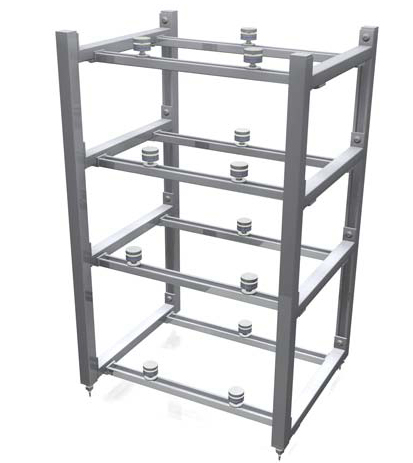
|
DANNY KAEY'S SYSTEM
LOUDSPEAKERS
ELECTRONICS
SOURCES
CABLES
|
Joe Ciulla, chief designer and owner of the EquaRack Corporation, based in New York City, may be the most driven man that I have come across in high-end audio. There are plenty of designers who won't stop until they have achieved their goals, but Joe simply never stops pushing the envelope. My encounter with Joe and the EquaRack started eighteen months ago, when I asked Dave Clark whether PFO was expecting any racks for review. My assortment of equipment had surpassed what my el-cheapo Target rack could support on its four shelves, so I was in the market for a new rack, plus I wanted to find out what the buzz surrounding equipment racks was all about. Luckily for me, Dave told me that Joe had just inquired about a review for his new rack.
The typical equipment rack is comprised of a solid support structure that contains several shelves for components. These shelves usually have some kind of damping to allow vibration to be drained away from the component. It was precisely this aspect that was the point of contention for Joe—the shelves themselves store the energy they were designed to drain from the component. Joe felt that this principle was not sufficiently resolved, so he started with a clean sheet of paper, and designed his rack so that the shelves would not be conductors and repositories of vibration. His engineering and architectural background and years of building experience, gives insight into vibration damping and isolation from things like earthquakes, category-5 hurricanes, and so on.
Before I laid eyes on Joe's behemoth, I was expecting the usual support structure, made of either high-grade wood or metal, and some form of suspended shelving, but nothing prepared me for what a friend and I had to schlep in my truck and then up the stairs to my second-story apartment. My first reaction was that something was missing. Where were the component shelves? The answer, of course, was that nothing was missing. I was simply looking at a rack unlike any other I had seen. The four-shelf, Model A EquaRack I received is a simple, ultra-modern-looking, 45-inch-tall unit. It is comprised of four cold-rolled, 12-gauge steel beams with ¼-inch TIG-welded end caps. These beams provide the fundamental strength of the rack. Each of these four columns is held together by another set of equally strong tiebacks and cross members, which are in turn held together by ½-inch alloy steel cap screws. Instead of shelves, the components are supported by three or four mount assemblies that ride within channels on the cross members. The entire freestanding structure looks rather empty, but don't be fooled—its exoskeleton is of such unprecedented rigidity and strength that EACH level supports a maximum weight of 800 pounds!
After we managed to wrestle the EquaRack upstairs to my listening room and get it installed, my friend, otherwise an enthusiastic supporter of my hobby, shook his head and declared that I had fallen over the edge. "How on God's green earth could this steel structure have ANY effect on the sound quality of your system?" he asked. I gave the standard explanation about vibration damping and making sure that the energy stored inside a component during operation has a way to exit, and so on, but I hadn't yet heard what the EquaRack could do. During the following months, I had plenty of opportunities to ponder his question, and have not only concluded that racks can have a dramatic impact on system performance, but that they should be regarded as either the very first step in your system or the very last, depending on how you feel about such things. Just a few years ago, I too regarded the subject of vibration isolation and energy transfer as lunacy. Today, science has progressed to such a level that we can effectively measure the impact of miniscule changes in equipment support. (Ginko, a manufacturer of inexpensive support shelves and similar devices, did an interesting demo at CES some years back, in which accelerometers attached to the base of a component measured the impact of vibration damping on that component's performance.)
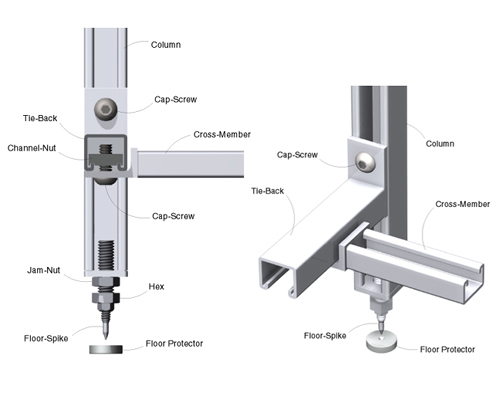
Each level of the EquaRack is infinitely adjustable in height, which allows for perfect component matching. Both the front and rear cross members that support the components move from front to back to accommodate the depth of each item. Thus, for my phono stage, the cross members are much closer together than they are for my amplifier, which is much deeper. The immediately apparent benefit of this ingenious design is that you can perfectly match each component to the corresponding "shelf." Since there are no actual shelves to trap circulating air, your amplifier and other components that require ventilation will "breathe" much easier than they will on any traditional rack. I found this a welcome feature, since my E.A.R. 890, which has four KT90 tubes per channel, runs quite hot.
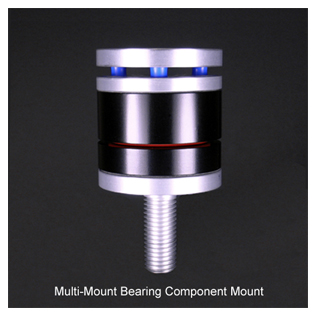
Joe recommends that you set aside one full day for building and adjusting the rack. It's not that the assembly is difficult. Quite the opposite—the manual is so straightforward and easy to understand that anyone should be able to put the thing together rather quickly. Much more time is required to make the various adjustments, and to complete the final part of assembly: placing your components on either Multi-Mounts (MMs) or Multi-Mount Bearings (MMBs). The MMs and MMBs offer unprecedented adjustability by allowing for a precise amount of damping and vibration control with the supplied Viscoelastic Pellets, the true key to the performance of the EquaRack. Each Viscoelastic Pellet has a defined weight limit, and performs best when optimally loaded. By varying the number of Viscoelastic Pellets used, you match each MM or MMB to the actual weight of the component. This all sounds rather dramatic and overly complex, but the practical implication is that once you make the proper adjustments, you will have a component support system that takes the requirements of each component into account, and that gives the optimal performance for each component. Clever and unprecedented indeed!
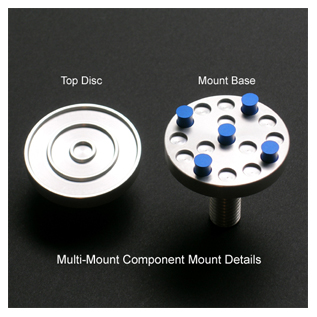 No aspect of the EquaRack was an afterthought. Even
the Viscoelastic Pellets have an exorbitant amount of R&D behind them. Joe had
to search extensively to find a manufacturer capable of delivering these unique
items, which are unlike any others available on the market. Each Pellet is
designed to provide undiminished performance for as long as fifteen to twenty
years, in stark contrast to other such elements, which typically have a shelf
life (no pun intended) of a year or so at best. The Multi-Mount Bearings may be
the EquaRack's most noteworthy feature. They use the Viscoelastic Pellets AND a
bearing of the highest quality ever made for an audio component. When I asked
Joe about the difference in performance between the MMs and MMBs, he told me
that any component that is motor driven would achieve the best benefit from the
MMBs. Therefore, your turntable and your CD or DVD player should ideally be
placed on Multi-Mount Bearings. Rather then going into further detail, I
encourage you to have a look at Joe's astoundingly informative website,
www.equarack.com, where you will learn more than you ever imagined about
vibration control, damping, and all of the other design aspects of the EquaRack.
By comparison, other rack websites look like children's books.
No aspect of the EquaRack was an afterthought. Even
the Viscoelastic Pellets have an exorbitant amount of R&D behind them. Joe had
to search extensively to find a manufacturer capable of delivering these unique
items, which are unlike any others available on the market. Each Pellet is
designed to provide undiminished performance for as long as fifteen to twenty
years, in stark contrast to other such elements, which typically have a shelf
life (no pun intended) of a year or so at best. The Multi-Mount Bearings may be
the EquaRack's most noteworthy feature. They use the Viscoelastic Pellets AND a
bearing of the highest quality ever made for an audio component. When I asked
Joe about the difference in performance between the MMs and MMBs, he told me
that any component that is motor driven would achieve the best benefit from the
MMBs. Therefore, your turntable and your CD or DVD player should ideally be
placed on Multi-Mount Bearings. Rather then going into further detail, I
encourage you to have a look at Joe's astoundingly informative website,
www.equarack.com, where you will learn more than you ever imagined about
vibration control, damping, and all of the other design aspects of the EquaRack.
By comparison, other rack websites look like children's books.
The best thing about the EquaRack may be the fact that Joe Ciulla is happy to talk about it with anyone, and most importantly his valued customers. Joe comes across as someone who spends every waking moment of his life devoted to the art and science of vibration damping and control. Our long conversations were always so full of information that I felt as if I had learned everything there was to know about the subject. Joe speaks with such confidence and authority that you can't help but feel that you have purchased something truly advanced and high-tech, based on good, solid science, with no snake-oil tactics involved.
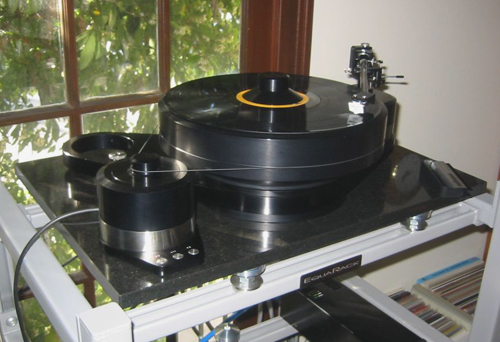
Upon completing the setup of the rack, my expectations were high, to be sure. I placed one LP of Tosca's new three-LP set onto my Brinkmann LaGrange and jumped into my listening chair. I figured that the Brinkmann would give me the best indication of the rack's performance, even though Joe was not happy about the fact that I was using a granite slab to support the turntable. According to Joe, the granite slab would only give a glimpse of the performance possible by using only the Multi-Mount Bearings. As with all platforms, Joe felt that the slab would trap too much energy and not allow for the proper exhaustion of these forces through the MMBs. Even before hearing the first note of the first track, I couldn't help but notice an immediate change in the sonic structure. I could already perceive that the background was blacker, and that there was less groove noise. Nevertheless, it was not until the first bass notes hit that I recognized what the EquaRack was doing. It wasn't that there was more bass, but I heard a whole new level of clarity, focus, and imaging bestowed upon these bass-heavy tunes. Spinning up more delicate music, I found that every last bit of glare had been eliminated from some previously edgy or hyped-up recordings, allowing more of the performance to shine through. The images improved dramatically with every record I played.
Equally as impressive was the improved performance of the ZeroOne Ti48 CD/HardDisk transport. I had made some copies of my favorite tunes while the Ti48 was sitting on the Target rack, and was already a big fan of its sound. With the unit resting atop the EquaRack, and with a Multi-Mount directly underneath the DVD-Rom's drive motor. the playback experience was altogether revelatory. Another ridiculous improvement came when I placed a Multi-Mount directly underneath my ReVox H1 four-motor, direct-drive cassette deck. This trusted deck of mine, now some thirteen years old, was spinning cassette tapes with such a high level of refinement that I made some new tapes just for kicks.
The EquaRack had removed the veiling, harshness, and glare that were clearly evident when listening to the same components on the Target rack. If you would have told me that the investment into the EquaRack would yield such critical performance increases I would have simply taken it with seven grains of salt and a good dose of "sure thing buddy, whatever you say". Witnessing these improvements in real life, however, was a most noteworthy experience. My system had taken on a whole new level of refinement and realism. Joe Ciulla is definitely onto something. Of course, this level of performance doesn't come cheap, and spending a few thousand dollars on a rack doesn't carry the same panache as owning the latest and greatest DAC and transport, but without doubt, the EquaRack will make your music sound better. Joe, who simply refuses to leave well enough alone, has created a true reference component. Danny Kaey
EquaRack
For
pricing, check the website, but the stand as reviewed
with three optional Bearing
Multi-Mounts is around
$2660. A "standard" Model-A
4-Level rack costs less at $2180.
EquaRack
web address:
www.equarack.com
A number of months after this review ran, Danny became the US Importer/Distributor for Zero One through conversations with Alvin Heng.
